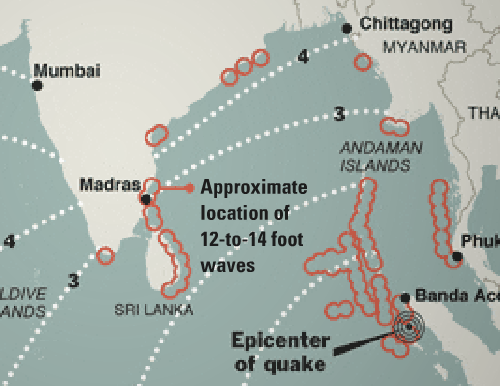What is a Tsunami and What Causes Them?
Tsunami, which is a Japanese word translated through English into “harbor wave,” is an enormous and destructive wave that scientists referred to as “seismic sea waves.” Many people may know tsunamis by their layman term, “tidal wave” (Dudley, p.28; Cook). Tsunamis are most common in the Pacific Ocean, specifically near Japan where they frequently wreak havoc on its harbors and coastal villages (Dudley, p.28). Tsunamis are in fact a series of extremely long waves that are primarily associated with earthquakes and coastal regions. However, landslides, volcanic eruptions, and even impacts of objects from outer space like asteroids and meteors can cause tsunamis. Tsunamis can reach speeds exceeding 600 mph and even in shallow waters reach heights of over 100 feet (NOAA). Tsunamis have in fact been reported since ancient times, with the first recorded tsunami occurring off the coast of Syria in 2000 B.C. (Lander, 1)
Tsunamis are caused by violent movement on the seafloor. Their generation is due to the ocean’s bottom rising or dropping, which displaces the column of water directly above it. This is most common in large subduction zones, where the collision of two tectonic plates causes the oceanic plate to dip beneath the continental crust (Lander, p.2). This movement on the seafloor can be caused by three different types of geologic activity. The first and most common is submarine faulting (as mentioned above), which actually causes earthquakes and tsunamis. It was originally believed that the earthquakes themselves were the cause of tsunamis, but that hypothesis has been revised (Dudley, p.33). The second most common geologic activity is a landslide. If a landslide were to start out above sea level and plunge into the sea a tsunami might occur. Also, tsunamis can be generated if a landslide occurs underwater. The third cause of tsunamis is volcanic activity. The production of tsunamis in this circumstance is quite similar to that of tsunamis caused by submarine faulting. An explosion of a submarine or shoreline volcano can generate a tsunami, as evidenced by the explosion of the island volcano Krakatoa in 1883 that killed over 36,000 people in Java and Sumatra (Dudley, p.34).
It should come as no surprise than that the Pacific Ocean is a source of the vast majority of tsunamis. This area is one of the most geologically active in the world, as the Pacific Ocean basin is surrounded by deep ocean trenches, explosive volcanic islands, and mountain ranges as well as the frequent earthquakes and volcanic eruptions that occur nearby
Now that you know what a tsunami is, it’s time to scare you with the terrifying results of what happens when a tsunami hits land!
Three types of Tsunami



Tsunami, which is a Japanese word translated through English into “harbor wave,” is an enormous and destructive wave that scientists referred to as “seismic sea waves.” Many people may know tsunamis by their layman term, “tidal wave” (Dudley, p.28; Cook). Tsunamis are most common in the Pacific Ocean, specifically near Japan where they frequently wreak havoc on its harbors and coastal villages (Dudley, p.28). Tsunamis are in fact a series of extremely long waves that are primarily associated with earthquakes and coastal regions. However, landslides, volcanic eruptions, and even impacts of objects from outer space like asteroids and meteors can cause tsunamis. Tsunamis can reach speeds exceeding 600 mph and even in shallow waters reach heights of over 100 feet (NOAA). Tsunamis have in fact been reported since ancient times, with the first recorded tsunami occurring off the coast of Syria in 2000 B.C. (Lander, 1)
Tsunamis are caused by violent movement on the seafloor. Their generation is due to the ocean’s bottom rising or dropping, which displaces the column of water directly above it. This is most common in large subduction zones, where the collision of two tectonic plates causes the oceanic plate to dip beneath the continental crust (Lander, p.2). This movement on the seafloor can be caused by three different types of geologic activity. The first and most common is submarine faulting (as mentioned above), which actually causes earthquakes and tsunamis. It was originally believed that the earthquakes themselves were the cause of tsunamis, but that hypothesis has been revised (Dudley, p.33). The second most common geologic activity is a landslide. If a landslide were to start out above sea level and plunge into the sea a tsunami might occur. Also, tsunamis can be generated if a landslide occurs underwater. The third cause of tsunamis is volcanic activity. The production of tsunamis in this circumstance is quite similar to that of tsunamis caused by submarine faulting. An explosion of a submarine or shoreline volcano can generate a tsunami, as evidenced by the explosion of the island volcano Krakatoa in 1883 that killed over 36,000 people in Java and Sumatra (Dudley, p.34).
It should come as no surprise than that the Pacific Ocean is a source of the vast majority of tsunamis. This area is one of the most geologically active in the world, as the Pacific Ocean basin is surrounded by deep ocean trenches, explosive volcanic islands, and mountain ranges as well as the frequent earthquakes and volcanic eruptions that occur nearby
Now that you know what a tsunami is, it’s time to scare you with the terrifying results of what happens when a tsunami hits land!
Three types of Tsunami






No comments:
Post a Comment